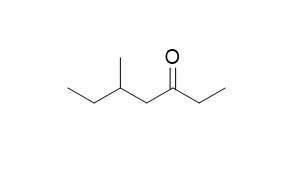5-Methyl-3-heptanone
5-Methyl-3-heptanone is a sex pheromone, can coordinate reproductive behaviour.
Inquire / Order:
manager@chemfaces.com
Technical Inquiries:
service@chemfaces.com
Tel:
+86-27-84237783
Fax:
+86-27-84254680
Address:
1 Building, No. 83, CheCheng Rd., Wuhan Economic and Technological Development Zone, Wuhan, Hubei 430056, PRC
Providing storage is as stated on the product vial and the vial is kept tightly sealed, the product can be stored for up to
24 months(2-8C).
Wherever possible, you should prepare and use solutions on the same day. However, if you need to make up stock solutions in advance, we recommend that you store the solution as aliquots in tightly sealed vials at -20C. Generally, these will be useable for up to two weeks. Before use, and prior to opening the vial we recommend that you allow your product to equilibrate to room temperature for at least 1 hour.
Need more advice on solubility, usage and handling? Please email to: service@chemfaces.com
The packaging of the product may have turned upside down during transportation, resulting in the natural compounds adhering to the neck or cap of the vial. take the vial out of its packaging and gently shake to let the compounds fall to the bottom of the vial. for liquid products, centrifuge at 200-500 RPM to gather the liquid at the bottom of the vial. try to avoid loss or contamination during handling.
Horticulture Research2020, 7:111.
Front Pharmacol.2021, 12:607403.
Fitoterapia.2022, 157:105130.
Heliyon.2023, 9(6):e16138.
J of Ana. Chem.2019, 74(11):1113-1121
Pharm Biol.2022, 60(1):2040-2048.
Biomedicines.2024, 12(3):495.
Appl. Sci.2020, 10,1304
Int J Mol Sci.202, 25(17):9246.
Appl. Sci.2023, 13(2), 860.
Related and Featured Products
Hydrobiologia, 1999, 402(1):145-161.
Nereidid polychaetes as model organisms for marine chemical ecology.[Reference:
WebLink]
Nereidid polychaetes and indeed many marine invertebrates use chemical signaling via sex pheromones to coordinate their reproductive behaviour. Sex pheromones attract the sexual partner and ensure the coordinated release of gametes by both sexual partners. In the current paper nereidids are used as model organisms to describe the chemical and behavioural basis of chemical communication in marine invertebrates.
METHODS AND RESULTS:
Structure-activity relationships can be used to chemically classify signals according to their biological function and suitable purification strategies are described. Pheromones in nereidids include diverse molecules such as volatile lipophilic 5-Methyl-3-heptanone and 3,5-octadiene-2-one, uric acid and small glutathione derived peptides. A prominent question in chemical signaling is the species specificity of chemical cues and the scale of their distribution in the marine environment. This evolves when one considers the wide overlap in multispecies and multiphyla spawning such as in coral reefs. Behavioural and electrophysiological assays with several nereidid species, confirm the existence of heterospecific activity of body fluids from various phyla. The `nuptial dance' reproductive behaviour, as well as the release of gametes, are elicited when individuals are exposed to coelomic fluid of another nereidid species and also from lugworms, starfish, and sea urchins. The function of sex pheromones in nereidid polychaetes and their role in the timing of reproduction in relation to other environmental cues is discussed.
CONCLUSIONS:
Future research will focus on biosynthesis and reception of nereidid pheromones as well as their molecular basis and possible interactions with pollutants such as endocrine disrupters and fuel oil derivatives.
Journal of Experimental Zoology, 1988, 246(3):285-292.
Sex pheromone in a marine polychaete: Determination of the chemical structure.[Reference:
WebLink]
METHODS AND RESULTS:
A sex pheromone of the marine polychaete Platynereis dumerilii is chemically characterized as 5-Methyl-3-heptanone. There exist two optical isomers, the S(+)-isomer produced by males and acting on females, the R(−)-isomer produced by females and acting on males.
CONCLUSIONS:
The basic structure shows a close relationship to insect pheromones and is of interest with regard to the evolution of pheromones.
Invertebrate Reproduction & Development, 1991,15:83-85.
Volatile compound from the coelomic fluid of Nereis succinea: biological activity as sex pheromone.[Reference:
WebLink]
CONCLUSIONS:
Volatile compounds in the coelomic fluid of ripe Nereis succinea (Frey & Leuckart 1847) were isolated by using a closed loop stripping technique and identified by GC-MS.
CONCLUSIONS:
One major compound is the sex pheromone of the closely related species Platynereis dumerillii, 5-Methyl-3-heptanone. This substance increases the swarming activity during the nuptial dance reproductive behaviour and induces the males to release a very small cloud of sperm.



